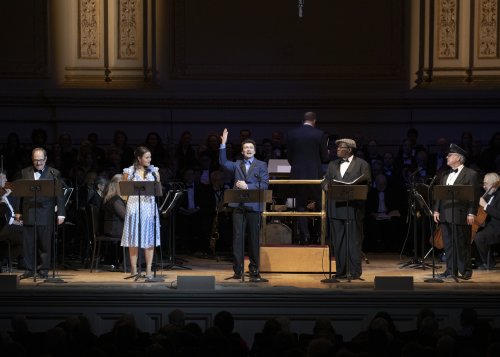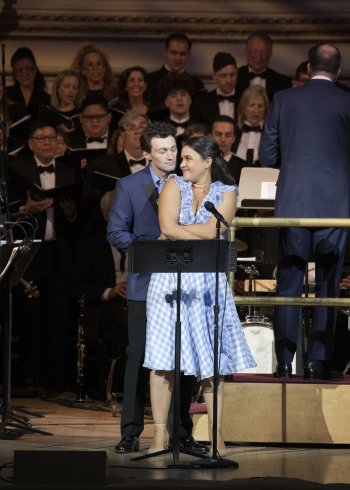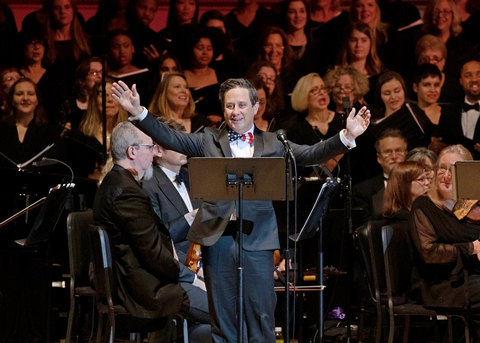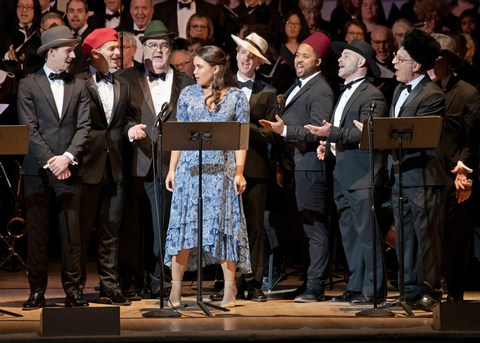Let ‘Em Eat Cake
Gloriously performed concert revival of Gershwin’s complex and sophisticated score of the sequel to the first Pulitzer Prize winning musical, “Of Thee I Sing.”

Lewis J. Stadlen, Mikaela Bennett, Bryce Pinkham, Chuck Cooper and Fred Applegate in a scene from MasterVoices’ revival of The Gershwins’ “Let ’Em Eat Cake” at Carnegie Hall on November 21, 2019 (Photo credit: Erin Baiano)
[avatar user=”Victor Gluck” size=”96″ align=”left”] Victor Gluck, Editor-in-Chief[/avatar]
There are flops and then there are flops. After winning the first Pulitzer Prize in Drama for a musical, the creators of the 1931 Of Thee I Sing (book writers George S. Kaufman and Morrie Ryskind, lyricist Ira Gershwin and his composer brother George) reunited to write a sequel, Let ’Em Eat Cake. While Of Thee I Sing was an acclaimed hit which ran 441 performances, the most of any Gershwin musical, Let ‘Em Eat Cake which opened on Broadway on October 21, 1933 was both a critical and financial failure running a mere 89 performances, even though it brought back much of the cast of the earlier show. However, this last George Gershwin musical is often considered a dry run for the opera Porgy and Bess which was the next and last show he wrote for the stage. With its counterpoint, multiple songs within musical interludes, and its duets and large choral numbers, this was the composer’s most complex score to date.
Having had a success with Of Thee I Sing in 2017, MasterVoices had chosen to stage the sequel with an equally starry cast made up of most of the singers from the previous show in the same roles. With a chorus of 125 voices in this most choral of musicals and nine stars, Let ’Em Eat Cake was gloriously sung. The orchestra of St. Luke’s under the baton of artistic director Ted Sperling gave the complex score a vigorous reading, suggesting that it is more than just a musical. While the story is quite silly (the White House gets painted blue, among other things), it is also quite dark predicting a fascist takeover of the American presidency – which may explain its quick failure in its own time. Topical in 1933, many of the topics and issues are currently in the headlines again as Washington deals with an imperial White House. The musical also offered a great many unfamiliar Gershwin songs aside from its one hit “Mine,” and familiar and unfamiliar reprises from Of Thee I Sing like “Wintergreen for President.”
Of Thee I Sing concerned John P. Wintergreen’s successful bid for the presidency on a platform of “Let’s put love in the White House,” after proposing to his girlfriend Mary Turner in all 48 of the then United States. Later President Wintergreen has to deal with an impeachment proceeding for breach of promise in the Senate, but when the First Lady announces that she is about to be a mother all charges are dropped and the Vice President agrees to marry the jilted lady.

Bryce Pinkham and Mikaela Bennett in a scene from MasterVoices’ revival of The Gershwins’ “Let ’Em Eat Cake” at Carnegie Hall (Photo credit: Erin Baiano)
The sequel begins several years later as President Wintergreen (Bryce Pinkham) and Vice President Throttlebottom (Kevin Chamberlin) are voted out of office, losing to John P. Tweedledee (Christopher Fitzgerald). When the Supreme Court refuses to annul the election, Wintergreen and his cabinet open a shop in Union Square selling blue shirts designed by the former First Lady Mary Wintergreen (Mikaela Bennett). Unfortunately, this business fails and they are stuck with a huge inventory.
After talking to agitator Kruger (David Pittu), Wintergreen decides to offer a revolution with the blue shirts (shades of Germany’s Brown Shirts and Italy’s Black Shirts) and the enterprise becomes a runaway success. The Blue Shirts plan to seize President Tweedledee when it turns out General Snookfield (Bill Buell) has gone missing (to a party) and the soldiers have no leader. President Tweedledee offers them “a dollar a day which I may not pay” while Wintergreen offers them the war debt owed by the League of Nations and Wintergreen is returned to office with the assertion that “the land of freedom is free once more.”
In the second act, the White House is being painted blue and the Supreme Court has been reconstituted as a baseball team. When representatives from the League of Nations arrive to discuss the repayment of war debts, Wintergreen suggests a baseball game to settle the question, double or nothing. Throttlebottom is made umpire although he is not happy about it. When the U.S. loses, the army now under General Kruger (replacing the disgraced General Snookfield) wants a scapegoat and turns to Throttlebottom. Prosecutor Kruger sentences him to the guillotine and then sentences Wintergreen and his cabinet as well for defending him. Kruger now declares himself dictator.

Christopher Fitzgerald in a scene from MasterVoices’ revival of The Gershwins’ “Let ‘Em Eat Cake” at Carnegie Hall (Photo credit: Erin Baiano)
Mary interrupts the beheadings with a fashion show and reminds the ladies that if Kruger is deposed revolutionary blue will not be the only color they can wear. Following the direction of the women, the army seizes Kruger, returning Wintergreen to office. However, he resigns in order to leave off revolutions and go into the dressmaking business with Kruger who formerly was successful in that line. Tweedledee returns and Throttlebottom becomes his vice president, but a problem develops when it turns out that Tweedledee has accepted an offer to become President of Cuba. This makes Throttlebottom the next president. After Wintergreen’s promise to the people of cake and Kruger’s promise of caviar, Throttlebottom promises the country a reprise of “Of Thee I Sing.”
Five members of the cast of Of Thee I Sing returned, with four of them in the same roles as previously with David Pittu now giving a forceful rendition of Agitator Kruger who rises to become Dictator of the United States. Bryce Pinkham was charming as President Winterbottom who becomes a revolutionary, while Kevin Chamberlin continued to amuse as the befuddled Throttlebottom. Lewis J. Stadlen joined Fred Applegate and Chuck Cooper as Wintergreen’s sardonic cabinet secretaries later turned cronies in the revolution.
The real surprise of the evening was the lush voice of Mikaela Bennett, new to the role of First Lady Mary Wintergreen, who impressed with her gorgeous soprano. Joining the cast as General Adam Snookfield, U.S.A., Bill Buell was a wry authoritative presence. In the small role of President-elect John P. Tweedledee, Fitzgerald made the most of his opportunities. The cast also included nine members of the chorus as supreme court justices, nine as foreign diplomats, nine more as interpreters, and six of the ladies as fashion show models, too numerous to list.

Mikaela Bennett and Chorus of Diplomats in a scene from MasterVoices’ revival of The Gershwins’ “Let ’Em Eat Cake” at Carnegie Hall (Photo credit: Erin Baiano)
The MasterVoices chorus and the Orchestra of St. Luke’s impressed with how well they knew the complex Gershwin score and gave a persuasive rendition of this unfamiliar music. The score to Let ‘Em Eat Cake is composed in a series of mini-musical sequences, something Sondheim was to popularize decades later. The eclectic influences included Handel, Shubert, Gilbert and Sullivan (“I am the very model of a modern major general”), Yiddish music, and blues, according to the program notes. An example of Gershwin’s genius was the opening number “Wintergreen for President” in counterpoint with “Tweedledee for President” which includes quotes from “Stars and Stripes Forever,” “Hail! Hail! the Gang’s All Here,” “A Hot Time in the Old Town Tonight,” “Dixie,” “The Battle Hymn of the Republic,” “Over There,” “Tammany,” “The Sidewalks of New York,” and “Hail Columbia,” explained elsewhere. Whether audiences realize all this or not, it makes the music very sophisticated, textured and penetrating.
The concert script adapted by Laurence Maslon, host and producer of the NPR series Broadway to Main Street, may not be witty but was certainly outrageous, and Fitzgerald doubling as the narrator had a great many funny lines. The dramatic staging by Sperling and the musical staging by Andrew Palermo was completely suitable for the small apron of Carnegie Hall’s Ronald O. Perelman Stage left by the huge chorus and orchestra which took up most of the space. Tracy Christensen was costume consultant for the mostly formal wear for the men while the attractive Fashion Show wardrobe for the women was courtesy of Rent the Runway. The sound design by Scott Lehrer never got in the way of understanding Ira Gershwin’s clever lyrics.
MasterVoices’ delightful evening devoted to The Gershwin’s Let ‘Em Eat Cake demonstrated that forgotten musical shows due to silly stories or poor books may still have impressive scores and make for beautiful music. While not a classic rediscovery, this performance of Let ’Em Eat Cake revealed once again the fertile genius of Ira and George Gershwin. The first rate revival cast certainly gave this rarely heard show their best shot.
Let ’Em Eat Cake (November 21, 2019)
MasterVoices
Carnegie Hall
Isaac Stern Auditorium/Ronald O. Perelman Stage, 57th Street and Seventh Avenue, in Manhattan
For tickets, visit http://www.mastervoices.org
Running time: two hours and 30 minutes with one intermission






Leave a comment